A fresh baguette is pure happiness. A thin and super crusty and crispy crust. A light and fluffy interior begging for lots of excellent produce, meats, and cheeses. When you ferment the dough for a long time, the taste of the baguette becomes a beautiful experience. This is my recipe for sourdough baguettes.
Baguettes are the perfect companion for almost any kind of dish. They are great with cheeses, vegetables, and meats of any sort.
My personal favorite is a Vietnamese sandwich called Bánh Mì. It’s a French baguette with various fillings, usually a protein like marinated pork, grilled chicken, tofu, or meatballs. Afterward, you top it with pickled daikon and carrots, fresh chilies, and coriander or cilantro leaves.
If you are just here for the recipe, you can press the button underneath to be automagically transported to the recipe:
Jump to Recipe Jump to VideoThe history of baguettes
Creating a recipe requires a lot of research. I research many different things. Methods for mixing, shaping, and baking. What ingredients are common, which are uncommon, and how did the item come to be? Did it take decades or even centuries to develop it from a different version, or did someone come up with it in a bakery or hotel kitchen?
I often find that historians disagree on how something came to be. In the end, all that’s left are a bunch of theories.
Baguettes are no different.
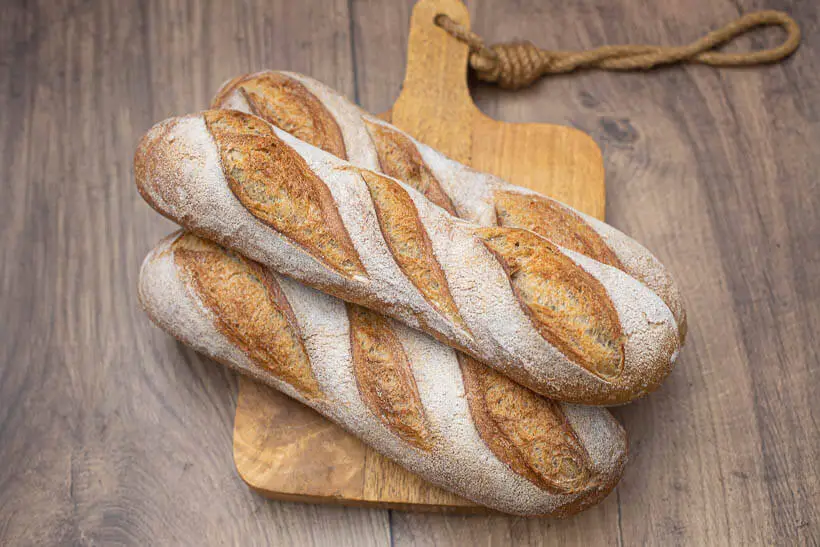
Napoleon, metro workers, or the French revolution?
One such story goes that Napoleon Bonaparte ordered the bread given to soldiers to be long and thin to fit in the soldier’s pockets.
Another story goes that when they started building the metro in Paris in 1898, workers were brought in from France to work on the project. Because of a violent outbreak between two groups of workers, they asked bakers to bake bread that could be torn instead of cut so that knives could be outlawed.
Yet another story goes that baguettes were part of inciting the French revolution. It’s been said that it infuriated the French peasants to see the nobility eating crusty white bread while they were starving.
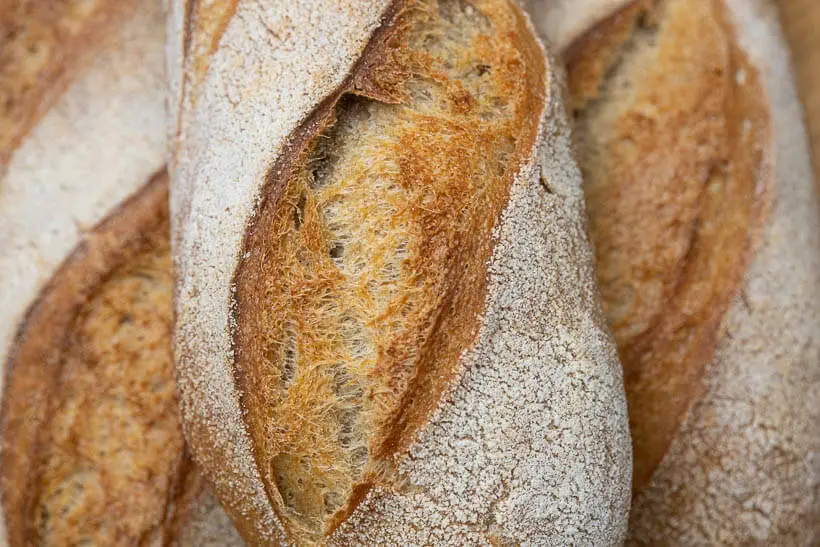
What about the modern baguette?
The origins of the modern baguette are not well known either. Still, it’s been said that the baker who is known for inventing the croissant, Austrian-born August Zang, facilitated the baguette because he brought the steam oven to France. Steam is needed to make the super crusty exterior of the baguette.
No matter how they came to be, baguettes are lovely and delicious.
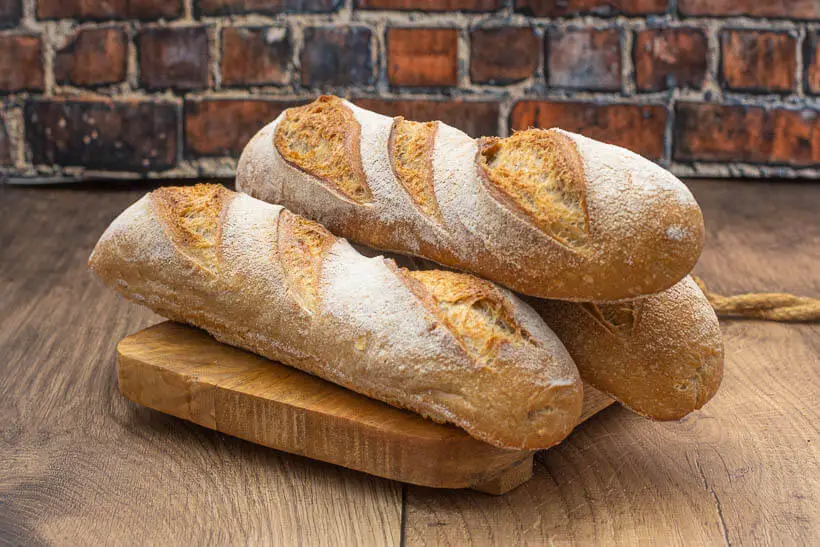
The dough in this sourdough baguettes recipe
Vitals
| Total weight | 1290 grams |
| Pre-fermented flour | 10% |
| Hydration | 70% |
| Yield | Three medium baguettes |
Dough
The dough for a classic french baguette is only white flour, but if you want a bit more grit and taste, you can add up to 20% whole grain flour without a problem.
The hydration is 70%, but I recommend that you start at 65% to make sure your flour can take that amount of water. The shaping will be close to impossible if the dough is too wet. The 2.2% salt brings out the taste of the wheat.
The inoculation is 22.2% which is in the normal range of 20%, which gives you a total fermentation time of around 5 hours at 21ºC/70ºF. If your kitchen is colder, you should use a higher inoculation; you should use a lower inoculation if it’s vastly warmer.
| Weight | Ingredient | Baker's Percentage |
|---|---|---|
| 675g | bread flour | 100% |
| 450g | water | 66.7% |
| 15g | salt | 2.2% |
| 150g | starter (100% hydration) | 22.2% |
If you want to change quantity, hydration, inoculation, or play around with the formula, you can do so here in my Bread Calculator.
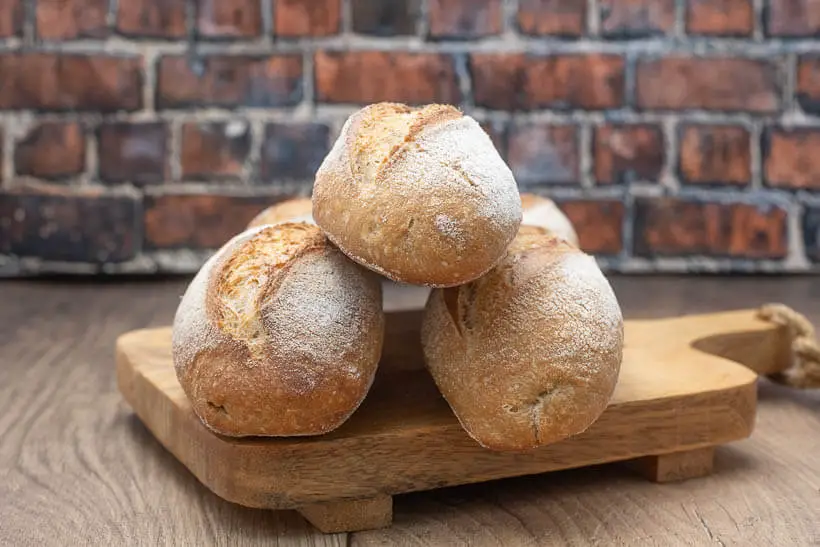
Tools for this sourdough baguette recipe
The complete list of tools needed to make sourdough baguettes:
- A baguette pan
- A bowl
- A bench scraper
- A lame
- Razor blades
- A small roasting pan
- A stand mixer
- A plastic bag big enough for the baguette pan
- A wire rack
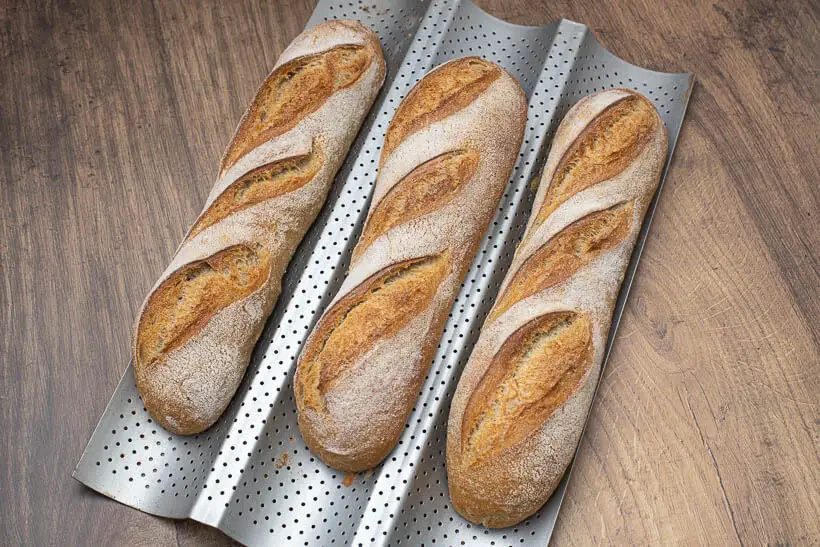
The conclusion of this sourdough baguettes recipe
This recipe delivers in all the ways I think are essential for a beautiful baguette?
- A thin and crispy crust
- A wonderfully soft and fluffy interior
- A well-developed taste
- Wonderful oven spring with defined scores in the final baguette
In all those respects, these sourdough baguettes deliver. It’s a joy to eat it and look at it. What more do you want? They are scrumptious.
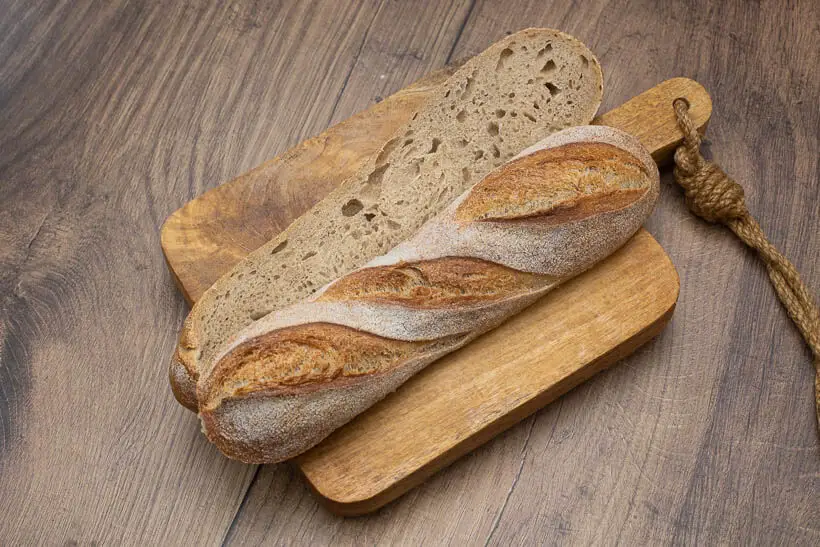
Please share this recipe for sourdough baguettes on social media
This is my recipe for crispy sourdough baguettes. If you like the recipe, please consider sharing it with like-minded bread lovers on social media.
If you make it and post it on Instagram, please tag me as @foodgeek.dk so I can see it. That would make me very happy.

Easy Sourdough Baguettes
Equipment
- small roasting pan
- big plastic bag
Ingredients
- 675 g bread flour
- 450 g water divided
- 15 g salt
- 150 g sourdough starter fed and grown to its peak
Instructions
Mix the dough
- To the bowl of your stand mixer add: 675g bread flour and 15g salt
- Mix with the paddle attachment on one until it’s been incorporated.
- Then add: 150g sourdough starter, and 400g water.
- Mix with the paddle on one until everything has been incorporated.
- Then switch to the dough hook and mix for 5 minutes on 3. While the dough is mixing, add as much of the reserved 50g of water as needed to make the dough tacky but not sticky.
- Check for a windowpane by pulling a little piece of dough out and see if it’s strong enough to stretch the dough so thin that you can see the light through it. If it fails, mix in increments of 2 minutes until it passes.
- Instead of using a stand mixer, you can also knead the dough by hand until you get a windowpane. It will probably take 10 to 15 minutes.
- When the windowpane passes, move the dough to a see-through bulking container.
- Wet your hands and level the dough. Then mark the top of the dough with a whiteboard marker.
- Then let the dough grow by 25 to 50%.
Shape the dough
- Then divide the dough into 3 equally sized pieces and dust the top with flour.
- Flip the dough over, roll it up into a tight log and do the same for the other two.
- Let them rest on the counter for 20 minutes, and then proceed to the final shaping.
- Grab a log and stretch it out to double the size you want the final baguette to be.
- Fold the right side into the middle and fold the left side into the middle.
- Then, going down the length of the baguette, fold the back towards the front, about to the middle. Then flip it 180° and then go down the baguette again, folding the back towards the front, all the way over.
- Then work the baguette across the table, pushing it forwards or backwards at the bottom of the dough, to work the baguette to the exact length that you want it.
- Then flour the pan with rice flour and add the baguette to the pan or you can also use a piece of parchment paper on the pan if you feel like the dough is a bit too wet. Continue with the other two the same way.
- Then sprinkle rice flour on top of all the baguettes and add them to a bag big enough to hold the pan.
- Put the dough in the fridge for at least 8 hours, but up to 48 hours.
Bake the baguettes
- When you want to bake, heat your oven to 230°Celsius/450°Fahrenheit/Gas mark 8. I didn’t use fan-assist or convection, but you can.
- Add a pan to the bottom of the oven used for steaming.
- I have a baking steel in my oven, which I heat it for an hour. You can bake when the oven says it’s hot enough.
- When the oven is hot, boil a kettle of water.
- Then grab the baguette pan from the fridge and sprinkle the top of the baguettes with rice flour.
- Score the baguettes with three long, slightly overlapping scores, grab the pan and add it to the hot oven.
- Pour the kettle of boiling water into the pan at the bottom and quickly close the oven.
- Bake for 8 minutes and then oven the oven and remove the steaming pan.
- Bake for about 25 to 30 minutes more until the baguette is golden brown and super crisp.
- Remove the pan from the oven and put the baguettes on a wire rack, and let them cool down, or you can serve them immediately.









